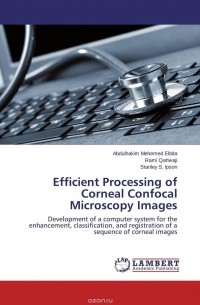Rami Qahwaji — новинки
-
Efficient Processing of Corneal Confocal Microscopy Images Abdulhakim Mehemed Elbita, Rami Qahwaji, Stanley S. Ipson
ISBN: 9783659674877 Год издания: 2015 Издательство: LAP LAMBERT Academic Publishing Язык: Английский Corneal diseases are a significant cause of visual impairment and confocal microscopes provide ophthalmologists with diagnostic sequences of images, at incremental depths, of the corneal layers and structures. However, many factors can make diagnosis more difficult including noise, non-uniform illumination both within and between images and eye movement during image capture. Aiding ophthalmologists working with long sequences of corneal images requires the development of new algorithms. The novel algorithms devised for this purpose and presented in this book are divided into four main categories: enhancement, to improve individual images; automatic classification to identify which part of the cornea each image belongs to; automatic reordering of images into the right sequence; automatic registration of the images with each other. -
3D Visualization of Solar Magnetic Loops Sofyan M. A. Hayajneh, Rami Qahwaji, Tufan Colak
ISBN: 9783659486937 Год издания: 2013 Издательство: LAP LAMBERT Academic Publishing Язык: Английский There are many different solar activities that may highly and unexpectedly impact our daily life. It is believed that the solar magnetic dynamic activity is almost the main driver of these activities. Establishing a novel, fully-automated, 3-D geometrical-based visualization system to help researchers to develop better understanding about the connectivity, structure and distribution of the solar magnetic loops is the main goal of the tools developed in this book. This system includes three novel fully-automated tools: 1) a tool to create high resolution and accurate magnetogram Carrington synoptic maps using the 2-D solar magnetogram images provided by NASA satellites, 2) an algorithm that can optimize the association of the different polarity magnetic footprints detected in the constructed Carrington maps, 3) a tool to process the created Carrington maps to 3-D model and visualize the magnetic loops structure. The developed system can be extended to model different solar feature’s from different wavelength images in a common visualisation environment using 3-D models, and hence saves the time that could be otherwise wasted on investigating different individual types of 2-D images. -
Detection of Breast Cancer Microcalcifications in Mammograms Ayman AbuBaker, Rami Qahwaji
ISBN: 9783659132629 Год издания: 2012 Издательство: LAP LAMBERT Academic Publishing Язык: Английский Breast cancer is the second leading cause of cancer deaths in women, exceeded only by lung cancer. Earlier detection, through non-invasive mammography scanning is extremely important for reducing the death rates from breast cancer. In this book we introduce an automated Computer Aided Diagnosis (CAD) system that can accurately detect cancer cells at early stages and reduce the workload of radiologists. The CAD system integrates image processing and machine learning technologies to simulate the way radiologists detect Microcalcifications in mammograms. The CAD system is tested on Benchmark data sets and reliable performance is achieved. This book will be useful for professionals interested in medical imaging technologies and also the development of CAD systems. It will be also relevant to academics and research students dealing with imaging, machine learning and medical research. -
AUTOMATED PREDICTION OF SOLAR FLARES Rami Qahwaji, Tufan Colak
ISBN: 9783838370309 Год издания: 2010 Издательство: LAP LAMBERT Academic Publishing Язык: Английский As we rely more on satellites, communication systems and space research, the importance of space weather is increasing continuously. There are many space missions and ground based observatories providing continuous observation of the Sun at many different wavelengths to supply the demand for space weather forecast and research. All the forecasting strategies highly depend on experience of solar physicists and done manually. The results differ from observatories to observatories and subjective. There is a need for automated analysis of Sun and space weather forecasting. The solar activity is the driver of space weather. Thus it is important to be able to predict the violent eruptions such as coronal mass ejections and solar flares. In this book a hybrid system combining image processing and machine learning techniques for the automated short-term prediction of solar flares is presented. The system can also detect, group, and classify sunspots using solar images. The algorithms, implementation, and results are explained in this work.




